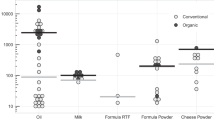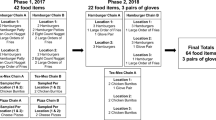Abstract
In 1999, the EU banned the use of certain phthalates as plasticizers for toys and childcare products. To check the plasticizers actually used, in the first half of 2007 toys and childcare articles consisting of plasticized PVC were collected at retail by the official control authorities in Germany, Austria and Switzerland. Extracts were analyzed directly by gas chromatography with flame ionization detection or mass spectrometry, but also after transesterification in order to detect larger molecular mass components and confirm the structures identified by direct analysis through the corresponding transesterification products. In 252 samples from 172 products, 17 different compounds were identified and determined quantitatively. Nearly half of the samples contained diisononyl-cyclohexane-1,2-dicarboxylate (DINCH) as the principal plasticizer. In second place were the phthalates (in 58 samples at concentrations above 4% w/w plastic, 23% of all samples), whereby they were frequently found in cloths (pinafores) and shoes, but seldom in baby articles. Of the other plasticizers used, all but two are approved for food applications or in the petitioning process: diisobutyl phthalate, found in 6 samples at 4–35%, and tri-(2-ethylhexyl) trimellitate, observed in 3 samples. Both are not considered suitable replacements for the banned phthalates.





Similar content being viewed by others
References
Stringer R, Labunska I, Santillo D, Johnston P, Siddorn J, Stephenson A (2000) Environ Sci Pollut Res 77:1–10
Wilkinson CF, Lamb IV JC (1999) Reg Tox Pharm 30:140–155. doi:10.1006/rtph.1999.1338
Shea KM (2003) Pediatrics 111:1467–1474
Babich MA, Chen S-B, Greene MA, Kiss CT, Porter WK, Smith TP, Wind ML, Zamula WW (2004) Reg Tox Pharm 40:151–167
Heudorf U, Mersch-Sundermann V, Angerer J (2007) Int J Hyg Environ Health 210:623–634. doi:10.1016/j.ijheh.2007.07.011
European Commission (2007). Guidance Document on the interpretation of the concept “which can be placed in the mouth” as laid down in the Annex to the 22nd amendment of Council Directive 76/769/EEC. http://ec.europa.eu/enterprise/chemicals/legislation/markrestr/guidance_document_final.pdf
Rastogi SC (1998) Chromatographia 47:724–726. doi:10.1007/BF02467461
Guerra RM, Marín ML, Sánchez A, Jiménez A (2002) J Chromatogr A 950:31–39. doi:10.1016/S0021-9673(02) 00051-1
Hauri U, Schlegel U, Wagmann M, Ch Hohl (2002) Mitt Geb Lebensmittelunters Hyg 93:179–18
Earls AO, Axford IP, Braybrook JH (2003) J Chromatogr A 983:237–246. doi:10.1016/S0021-9673(02) 01736-3
Fiala F, Steiner I, Kubesch K (2000) Dtsch Lebensmitt Rundsch 96:51–57
Bouma K, Schakel DJ (2006) Food Addit Contam 19:602–610. doi:10.1080/02652030210125137
Biedermann-Brem S, Biedermann M, Fiselier K, Grob K (2005) Food Addit Contam 22:1274–128. doi:10.1080/02652030500309426
Grob K, Biedermann M (2002) Anal Chem 74:10–16. doi:10.1021/ac0107554
Grob K (2001) Split and splitless injection for quantitative GC. Wiley, Weinheim. ISBN 3-527-29879-7
Fankhauser-Noti A, Grob K (2006) Trends Food Sci Technol 17:105–112. doi:10.1016/j.tifs.2005.10.013
EFSA (2006) 12th list of substances for food contact materials. EFSA J 395–401:1–21
EFSA (2005) 10th list of substances for food contact materials. EFSA J 273:1–26
Borch J, Axelstad M, Vinggaard AM, Dalgaard M (2006) Toxicol Lett 163:183–190. doi:10.1016/j.toxlet.2005.10.020
BfR (Bundesinstitut für Risikobewertung, 2007). Di-isobutylphthalat in Papieren und Kartons für den Kontakt mit Lebensmitteln. (http://www.bfr.bund.de/cm/216/di_isobutylphthalat_in_papieren_und_kartons_fuer_den_kontakt_mit_lebensmitteln.pdf
European Commission (2005) Synoptic Document. http://ec.europa.eu/food/food/chemicalsafety/foodcontact/synoptic_doc_en.pdf
Author information
Authors and Affiliations
Corresponding author
Rights and permissions
About this article
Cite this article
Biedermann-Brem, S., Biedermann, M., Pfenninger, S. et al. Plasticizers in PVC Toys and Childcare Products: What Succeeds the Phthalates? Market Survey 2007. Chroma 68, 227–234 (2008). https://doi.org/10.1365/s10337-008-0672-9
Received:
Revised:
Accepted:
Published:
Issue Date:
DOI: https://doi.org/10.1365/s10337-008-0672-9




